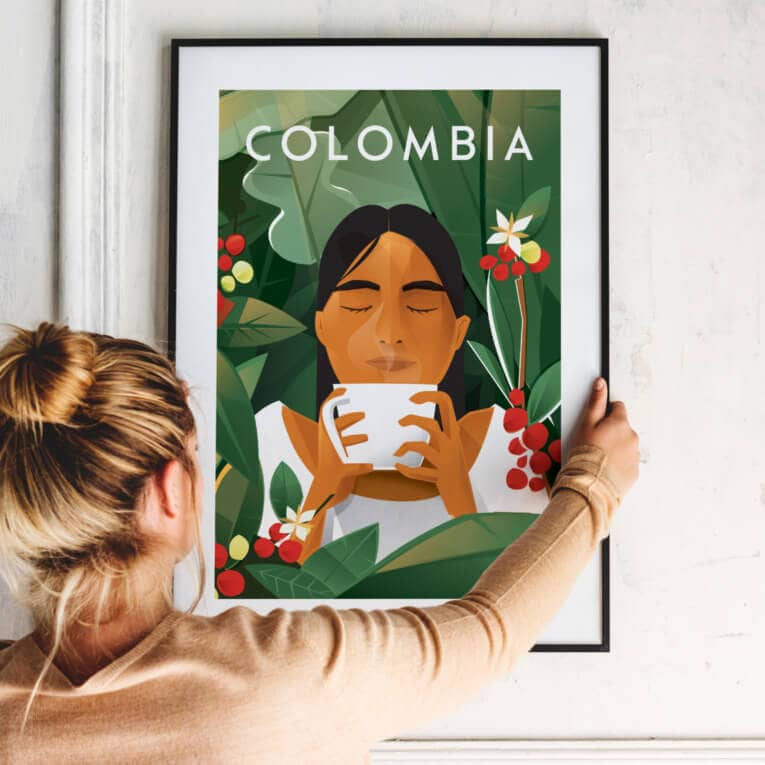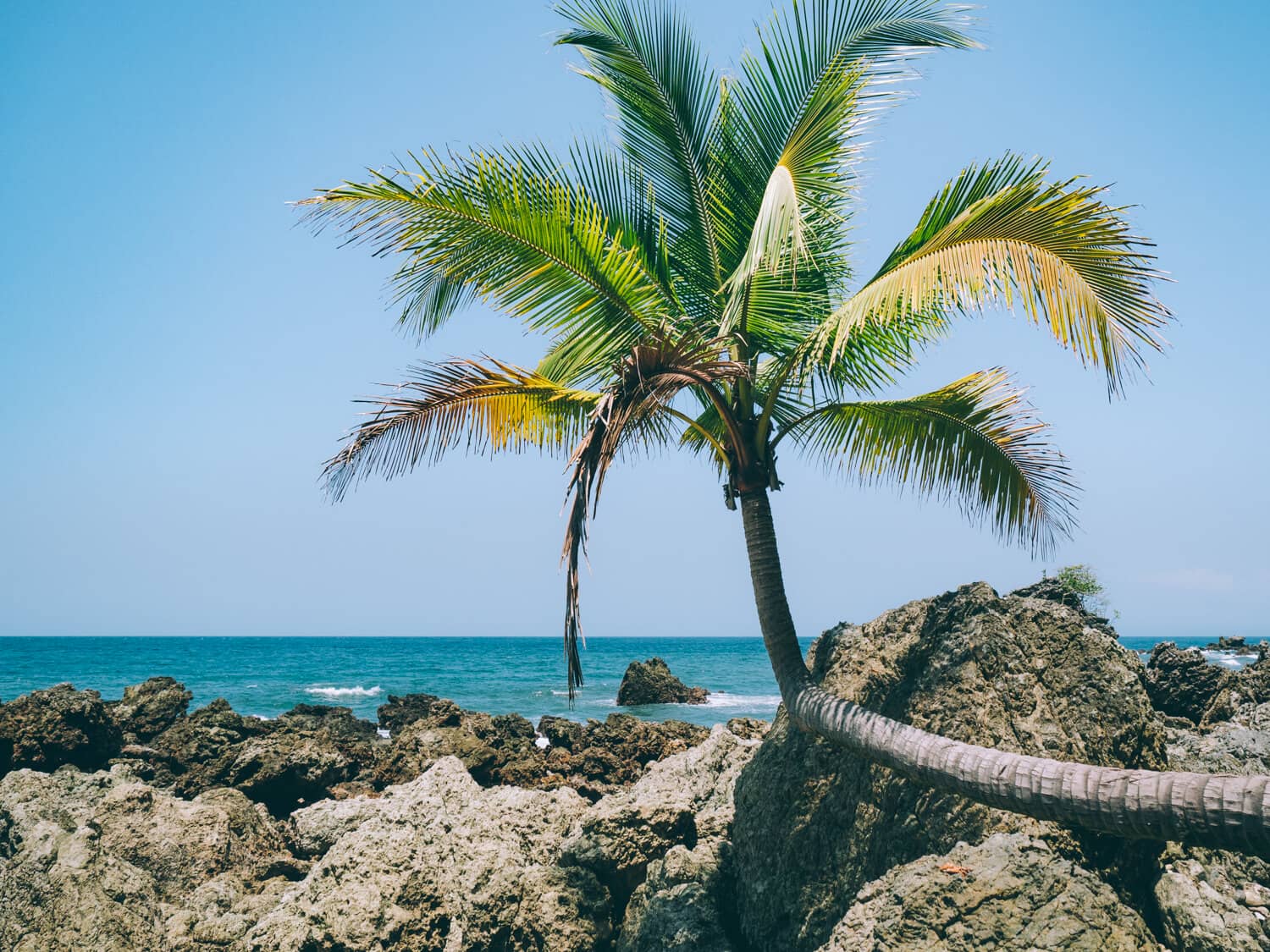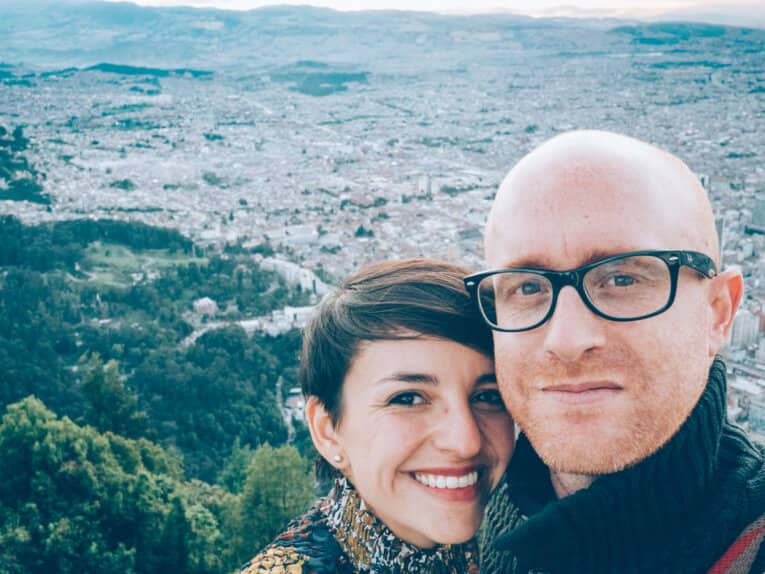When planning a trip to Colombia, the question of money quickly comes up. You need to prepare your budget, of course, but you also need to think about how you’re going to manage your money when you’re there.
What means of payment should you use? Should you withdraw money on the spot, or pay for everything with your bank card? What fees do banks charge? Is it easy to find cash dispensers in Colombia?
These are just some of the questions we’ll be answering in this post.

Travel Poster “Café de Colombia”
Buy our beautiful prints to get a taste of Colombia at home
Disclaimer: we apologize in advance for any grammatical or syntactic errors, as our native language is not English (we're a Colombian-French couple), so we hope you'll forgive us and still enjoy the information we share with you! Please note that all the information on our blog is based on our own experience, and is checked and updated regularly.
Withdrawing money in Colombia
CASH DISPENSERS IN COLOMBIA

Is it easy to find an ATM in Colombia?
You’ll often (but not always) find at least 1 ATM to help you out if you need it. That said, you should be aware that ATMs may not be available in small villages.
If you go to these places, you’ll need to bring enough cash with you. This is what we did when we spent a week in El Valle, or when we went to meet the Arhuacos in the Sierra Nevada or to enjoy Capurgana..
Feedback
In our experience, or according to feedback from our readers, you won’t find a distributor in : Capurgana, Nuqui, El Valle, Rincon del Mar, Palomino, Cabo de la vela, Islas del Rosario, Minca, Puerto Nariño, non-exhaustive list…
What are the withdrawal limits in Colombia?
Each bank, and therefore each ATM, has a maximum authorized withdrawal limit of between $300.000 COP and $2.000.000 COP, depending on the bank.
In our experience, Davidienda offers maximum withdrawals of $2.000.000 COP.
You should also be aware that in cities like Cartagena, ATMs can run out of cash very quickly, especially at weekends.
We recommend that you always withdraw as much money as possible at once, to minimize withdrawal fees.
What are the withdrawal charges?
If you use your traditional CB card, your bank will apply fees, often in excess of 2%, or sometimes fixed amounts. On top of these, you’ll have to pay ATM fees.
We really advise you to open a free account with a bank like N26 and Revolut, and get a card with which you can pay and withdraw money free of charge (or with reduced charges).
Our advice: use a free “special traveler” card!
Of course, you shouldn’t use your traditional bank card, as banks charge high fees for withdrawals abroad.
We recommend using a free bank card designed especially for travelers, such as N26 and Revolut, which charge little or no fees on withdrawals abroad (and can be used to pay everywhere, free of charge)
Are there any ATM (automated teller machine) fees?
Depending on the ATM used, fees are charged by the ATMs themselves (around $14.000 COP on average). The amount of these charges is usually displayed at the time of withdrawal.
Some travellers tell us that Davivienda and BBVA ATMs do not charge any fees. Others tell us that the same applies to Pichincha and Colpatria ATMs.
We contacted Davivienda to find out more, and they confirmed that no matter what happens, charges will be applied to all withdrawals.
Your bank’s withdrawal/spending limits
You should also be aware of your bank’s maximum weekly withdrawal or spending limits.
Before you leave, check with your bank to see if you can increase your weekly spending/withdrawal limit, or you’ll be in for a nasty surprise when you get there.
All the more reason to opt for a bank card such as N26 and Revolut, which offer extremely high spending limits , so you won’t have any problems with such limits during your trip.
Important information at the time of withdrawal
When you make a withdrawal, depending on the country you’re in, the cash dispenser will ask you a number of questions to which you’ll need to give the right answer! If you don’t, you’ll pay unnecessary charges!
- If asked “Cuenta ahorros” (saving account) or “Cuenta corriente” (checking account)
Always choose “Corriente” (“Checking Account”) - If asked to choose the transaction currency:
Always choose a transaction in local currency, i.e. Colombian Peso - If asked “with conversion” or “without conversion”:
Always choose “without conversion” or “sin conversion”
These rules also apply when paying in stores, restaurants, etc.
Security tip for cash withdrawals
When it comes to security, especially in big cities, you should always use cash dispensers in enclosed areas: inside banks, of course, but you’ll also find them in shopping malls, large supermarkets, etc.
Changing euros into Colombian pesos
CURRENCY, EXCHANGE RATES, BANKING SERVICES..

What is the currency of Colombia?
CURRENCY: THE COLOMBIAN PESO (COP)
Although its international currency symbol is the COP (Colombian Peso), in shops, prices are displayed with the $ sign. Yes, it’s the dollar sign, as in all Latin American countries where the peso is the currency.
The Colombian Peso has the peculiarity of being a currency with lots of zeros! So you’ll quickly find yourself with hundreds of thousands of pesos in your pocket… There are bills of $1000, $2000, $5000, $10.000, $20.000, $50.000 and $100.000 COP and coins of $20, $50, $100$, $200, $500 and $1000 COP.
What is the Colombian peso exchange rate?
We use xe.com to check the daily Colombian peso rate
When you’re in Colombia, whether at a bank or an exchange office, you’ll find that the exchange rate is more attractive in the big cities than in the smaller ones.
Please note: the exchange rate on the Internet (xe.com) does not correspond to the exchange rate applied by the banks or exchange offices themselves, which charge fees.
Should I change euros into Colombian pesos?
When planning your trip to Colombia, you may wonder how to change euros into Colombian pesos:
- You can exchange them before leaving
- You can do the exchange when you arrive in Colombia.
- Or don’t exchange at all (our advice)
The third solution is the best from our point of view: don’t change any money and withdraw pesos in Colombia with a card that charges little or no fees for foreign withdrawals (such as N26 and Revolut).
Our advice: don’t exchange currency!
The exchange rates applied by banks or exchange offices are often less attractive than those applied by cash dispensers.
Of course, you shouldn’t use your traditional bank card, which often charges high fees for withdrawals abroad.
We advise you to use a free bank card such as N26 and Revolut, which charge little or no fees for withdrawals abroad (in addition to being able to pay everywhere without any fees)
Changing euros in Colombia
In Colombia, you can exchange euros either in traditional banks or in “casas de cambio”, exchange offices.
Changing euros in a Colombian bank
Banks can be found in every city in the country. They can also be found in most tourist villages. Opening hours are usually Monday to Friday, from 9 a.m. to 4 p.m. maximum.
Depending on the city and district, not all bank branches offer currency exchange facilities.
Colombian banking hell
Banks in Colombia can be hellish. It’s more than common for the counters to be crowded, and on weekly pay days there are huge queues right out into the street!
Changing euros at a bureau de change
Currency exchange offices can be found in all major Colombian cities, and particularly in the most popular tourist destinations. You’ll also find them at major airports.
They apply approximately the same exchange rates as banks. Exchange offices are open approximately from 8 a.m. to 7 p.m. every day except Sunday.
Changing euros on the street
This is a very bad idea! Don’t be tempted… you could end up regretting it (scams, robbery, counterfeit bills, money laundering, assault…)
Change euros before you leave
Frankly, this isn’t very practical, as pesos are not a common currency that exchange offices have in stock. Most of the time, you have to “order” them.
There are solutions which offer the possibility of “ordering” pesos online and then picking them up at their office. But of course, these agencies don’t have offices everywhere and it’s not the best solution from our point of view.
Free bank cards abroad
The best traveller’s banks

As we explain at length in our post dedicated to the new no-fee bank cards, we use these cards on all our trips to Colombia, and it’s a bé-né-dic-tion!
- We pay no fees on all our travel payments.
- Account opening and management is totally free
- The Mastercard is free.
- It’s a real bank.
- Opening an account is quick and easy.
Free bank cards for traveling and avoiding bank charges
There are currently three offers that we consider to be the best on the market for travelers.
These are new banks offering more or less the same services dedicated to travelers: account opening and a free bank card that lets you pay anywhere abroad without any bank charges.
Sounds too good to be true? Well, it isn’t. We’ve been using an N26 card and a Revolut card for all our trips abroad since 2017!
As the account management is free, we only use these cards for our travels, they complement our traditional bank account.
We credit the money from our travel budget to the card, which makes it easier to manage (the mobile apps are super handy) and above all saves us money!
Travel banks: Free debit cards abroad
N26 Standard
Benefits
- Free payments
- 1.7% low fee on withdrawal
- 100% free administration
- Serious German company
Disadvantages
- For European citizens only
- No free withdrawals
Revolut Standard
Benefits
- Free payments on week days
- 100% free administration
- $200 USD/month withdrawals no fee
- Switch currencies on the fly
- Credit by card
Disadvantages
- Small payment fees on week-ends
Send money to Colombia free of charge
INTERNATIONAL TRANSFER

Finally, I’m going to tell you about one last practical solution for sending money free of charge! It’s possible with Remitly, which offers a high-performance service for sending money to Colombia: it’s fast, easy to use and inexpensive.
Is it really free?
The first transfer is really free. You’ll see this anyway when you use the platform, as everything is transparent. Then, if you use the platform several times, you’ll see that Remitly ‘s fees are fixed and very low indeed.
In our opinion, Remitly is the best platform for sending money to Colombia, and you can read our comparison to see for yourself.
Secondly, Remitly’s exchange rates are the best on the market, and the fees applied are really low compared with the usual bank charges. So, whatever happens, it’s a win-win situation.
Example of use: paying a deposit to book an activity in Colombia
You want to book an activity or an excursion in Colombia and the local service provider asks you for a deposit on a Colombian account?
Use Remitly to send your money securely and very quickly (the service provider receives the money within the hour). This means you can pay for a reservation with a Colombian service provider from abroad… and that’s pretty interesting.



Hello,
We are continuing to prepare our trip to Colombia in 2023 and your practical information is very useful
Do you know if there is an ATM in the arrivals hall at Bogota airport?
If not, are the exchange offices open late at night as our plane arrives at 10pm and we need money to pay the cab
Many thanks in advance for your help.
Hello Karine,
Yes, you’ll find cash dispensers at the airport, as well as exchange offices. I think they’re open until late, or even 24 hours.
For Davivienda, ATM withdrawals are not free; on the contrary, the charges are high: 7.1% of the amount withdrawn
With our N26 card we don’t pay any fees in Davidienda ATMs so that’s weird, maybe there are cities where it’s different? Or maybe you use a CB card that charges fees? It’s hard to answer specific questions like that, but I’m sorry if you had to pay a fee!
If I have money transferred to Colombia with Azimo and I am going to withdraw this amount in Colombia, do you know if Bancocolombia charges a fee for the withdrawal and if so how much. Thank you
Hi Jean Paul, Bancolombia doesn’t charge any fees. In fact, when you make the transfer Azimo gives you the corresponding amount in Pesos and this is the amount you get back at the counter. So you know in advance how many Pesos you’re going to get back. If ever, when you get the money back, you see a difference with what was planned by Azimo, can you come back here and let us know? Thanks a lot!
Hello,
Merci bcp pour tous vos précieux conseils. I opened a Revolut account for my trip to Colombia (2 weeks and a half). In an article you write “if you are Swiss or Canadian”, you can use this card. So if I understand correctly, if I’m French, it won’t work in Colombia?
Bonne journée,
Victorine
Not at all, it’ll work fine even if you’re French, it’s just that we recommend N26 in general and that for those who wouldn’t have access to N26 like the Swiss and Canadians, then Revolut is a good alternative. But again, no worries, we also have Revolut and it works well in Colombia 😉
Hello Samuel, Transferwise is no longer a good option for sending money to Colombia. They don’t do it anymore… The best option now is Azimo. It’s an app that lets you send euros in pesos with an exchange rate above that of the banks (today 3504 pesos) with a fee of 1 euro per transaction (the first two are free). I tested it and was very satisfied, since you can pay in euros with your Mastercard (from N26, for example) on Azimo and send them in pesos directly to the Colombian account of your choice (as long as the person has a Bancolombia or BBVA account (and other banks too, I think). You can also send money directly to the bank and withdraw it at the counter (with Bancolombia, Davivienda and Financierapagos). And it only works one way..
In any case, I found it honest and really additional to the N26 card (which I ended up taking thanks to your blog)
Thanks for all your advice, and keep up the good work on Colombia, I’m really interested
I’m going to live there forever in a few months (Colombian wife and little French/Colombian daughter)
See you soon!
Hi Elouan, thanks a lot for your comment, it’s with readers like you that the blog progresses 😉 To tell you the truth, we were just in the process of updating the article, and we have a friend who also told us about Azimo, which seems to be the ideal solution. As soon as we’ve got 5 minutes, we’ll update it with a bit more info on money transfers, because it can be very handy in case of a problem! As for N26, we agree, it’s a great plan! 🙂 Congratulations on your plans to move to Colombia, we’re thinking about it too, but it won’t be for a few years 😉 See you soon!
Hello,
Thank you for all this information! Would you by any chance have any tips on how to transfer/change COP to euros, avoiding bank charges?
Thanks in advance,
Olivia
Hello Olivia, I understand that Transferwise is a solution that, without avoiding fees, reduces them to a minimum compared to a classic bank transfer.
Hello
thank you for this excellent information regarding money flows, withdrawals etc
I followed your advice and took N26, seems much better than the sponsor of Roland Garos !
Merci pour votre aide et votre site bien vivant
Jean
Hi Jean, thank you for your comment and we’re glad you found our advice useful! Yes, N26 is definitely a good option for traveling, we agree that it’s a change from traditional banks 😉
I don’t agree with you at all, as long as N26 is free, with no management fees, and with more interesting withdrawal fees, plus other services, I don’t see how CZAM, which also has a lot of negative feedback, would be a better solution, but that’s just my opinion! 🙂
Thanks for these tips. And for online banks, do you know if withdrawals are expensive?
Hi Olivier, N26 is an online bank 😉 For the more “classic” online banks, I have no idea, just like the “hard” banks, you’ll have to take a good look at the rates in your contract. From my point of view, nothing comes close to a free N26, with no account-keeping fees, no fees for foreign payments and minimum fees for withdrawals…
Thanks for the article. Apparently, you haven’t tested the Pinchicha bank (?) not only are the maximum withdrawals one million, but above all, there are no fees. I tested in Bogotá and Cartagena for a total of 9 million, no worries. I even withdrew 4 million in 4 withdrawals and I think I could have done more. Thanks Pinchicha, since all other banks charge 12,000 pesos per transaction, often limited to 300,000.
Thanks for the tip Pierre! 🙂 We’ll look into it on our next trip, it could be very interesting indeed, hopefully we won’t have to go all over town to find a Pichincha dispenser 😉
See also Colpatria, Davivienda, BBVA where withdrawals are free.
Not forgetting Colpatria and Davivienda Bbva, where withdrawals are also free.